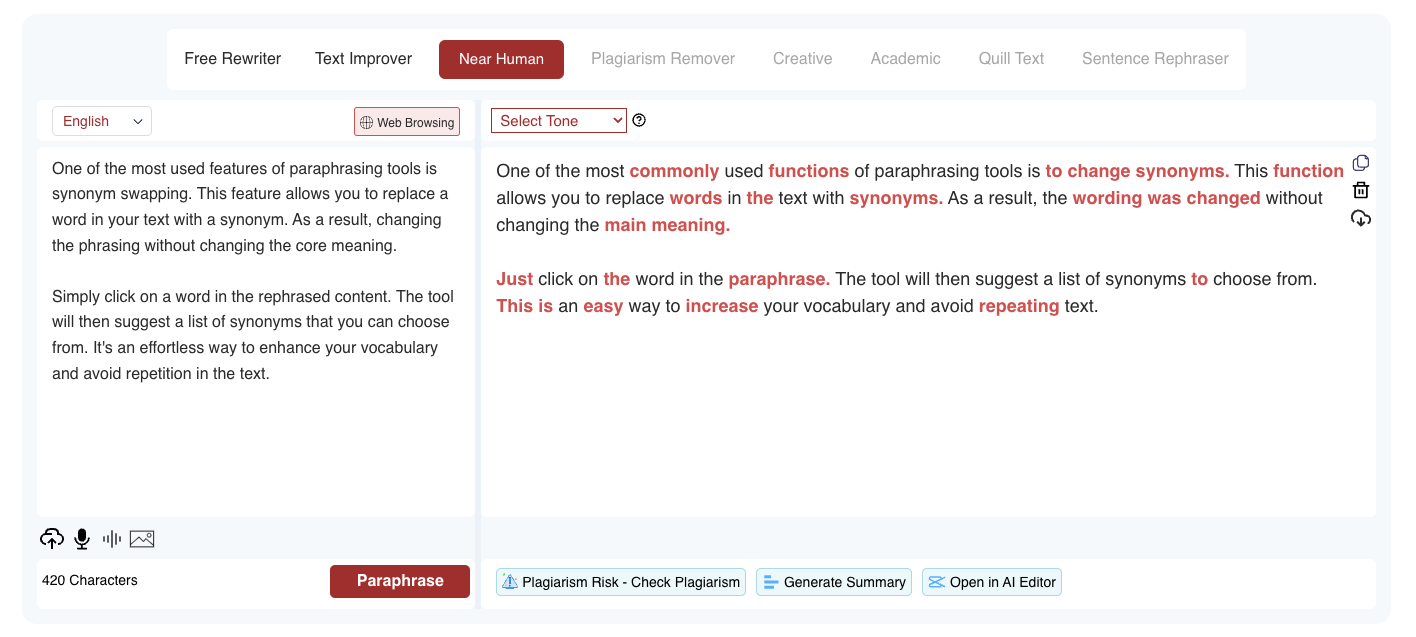Paraphrasing tools have emerged as indispensable allies for content creators. This article aims to deepen your understanding of these tools.
It sheds light on the tips about how to use them effectively, and most importantly, how to master them.
What are Paraphrasing Tools?
Paraphrasing tool are AI-powered online tools that use advanced algorithms and Natural Language Processing (NLP) to understand, rephrase, and refine your content.
These tools are the rewording tools that help content writers rephrase and rewrite their content. They act like thesauruses on steroids, but there’s more to them than just finding synonyms.
They dissect sentences and switch words for suitable synonyms. So, the sentence structure is changed all while aiming to retain the original meaning.
Paraphrasing Tools: Benefits and Potential Drawbacks
One can’t deny the benefits of using rewriting tools. These tools offer the following benefits:
- Save time
- Enhance vocabulary
- Generate fresh content ideas
For example, Paraphrasingtool.ai claims to help you rewrite the text in less than 10 seconds.
However, they aren’t without their pitfalls. Over-reliance on these tools may lead to a loss of personal writing style and tone, and sometimes even the essence of the original content. Therefore, it’s important to balance their use with manual editing.
Five Tips to Master the Use of Paraphrasing Tools
Using the paraphrase tools effectively requires a bit of skill and understanding. We’ve compiled five key tips to master the use of rewriting tools to help you navigate through the details.
You’ll be well on your way to creating high-quality, engaging, and unique content with these strategies in hand.
Change the Writing Style For the Target Audience
Paraphrases can switch writing styles depending on your target audience. It is rewriting modes that help you change the text according to the audience.
Take Paraphrasingtool.ai as an example. It offers eight different rewriting modes, allowing you to tailor your text according to your needs. Just to mention a few:
Near Human: As the name suggests, this mode gives your text a natural and conversational tone, almost as if it were written by a human and not an AI.

Academic: When you’re aiming for a scholarly audience, this mode comes in handy. It structures your content with precision and formality typical for academic writing.
Creative: Looking to unleash your imaginative side? The creative mode gives your text a stylistic flair, allowing for more expressive and artistic language.
These are just a few examples of the versatility offered by this tool, enabling you to alter the tone of your text to suit the occasion.
Swap the Words With their Synonyms
One of the most used features of paraphrasing tools is synonym swapping. This feature allows you to replace a word in your text with a synonym. As a result, changing the phrasing without changing the core meaning.
Simply click on a word in the rephrased content. The tool will then suggest a list of synonyms that you can choose from. It’s an effortless way to enhance your vocabulary and avoid repetition in the text.
Let’s look at an example.
Original sentence: The dog quickly ran across the street.
You could use the tool to swap “quickly” with “rapidly”, or “ran” with “dashed”.
The sentence becomes “The dog rapidly dashed across the street,” retaining the same meaning but offering a fresh perspective.
Practice with different sentences and explore how synonym swapping can invigorate your writing.
Fix any Improper Sentences
Rephrasing sentences is about reconstructing the sentences while retaining the original meaning.
Techniques can range from changing active voice to passive, reordering sentence parts, or combining or splitting complex sentences.
Sentence rephrasing can be employed in different writing situations, be it blog writing, academic essays, or creative storytelling.
The key is to understand your audience, their language comprehension levels, and the tone that fits the context best.
Click on any sentence that you want to change in the rephrased text. You will get five options to replace that sentence. Select the one that you think is most suited for your target audience.
Do not Underestimate the Manual Editing
Automation, while incredibly useful, is not flawless. It can sometimes lead to awkward phrasing or fail to capture nuanced meanings.
This is where manual editing comes in.
Most rewriting tools like Paraphrasingtool.ai comes with a powerful AI editor that simplifies the editing process. It effectively polishes and tweaks the paraphrased content. Features include:
- Simplify complex sentences to enhance readability.
- Automatically generate examples to support your text.
- Elaborate on your points for a comprehensive understanding.
- Create lists and bullet points for better structuring and clarity.
These features make sure you strike the perfect balance between automated paraphrasing and manual editing.
Final Check the Content for Plagiarism
While paraphraser help creates unique content, it’s crucial to avoid plagiarism. You need to ensure that the ideas you present are truly your own or properly attributed.
To help you stay original, the paraphrasing tools offer a built-in plagiarism checker. This feature checks your paraphrased content for any duplication, helping you stay on the safe side of ethical writing.
The best part? It comes complimentary with the tool, offering you peace of mind as you create engaging content.
Mastering Paraphrasing Tools: A Recap
Mastering paraphrasing tools requires understanding their features, such as versatile modes for different writing styles, synonym swapping, and sentence rephrasing.
You should also maintain a balance between automated outputs and manual editing with the AI editor is crucial for producing high-quality, engaging content. Also, staying ethical and avoiding plagiarism is of utmost importance, and tools like the built-in plagiarism checker can be a great ally in this.
As with any tool, mastery comes from continuous learning and experimentation. These tools evolve and improve over time, and staying up-to-date with the features can improve your writing skills.
So, don’t shy away from trying out different modes, testing various features, and continuously tweaking your content.

